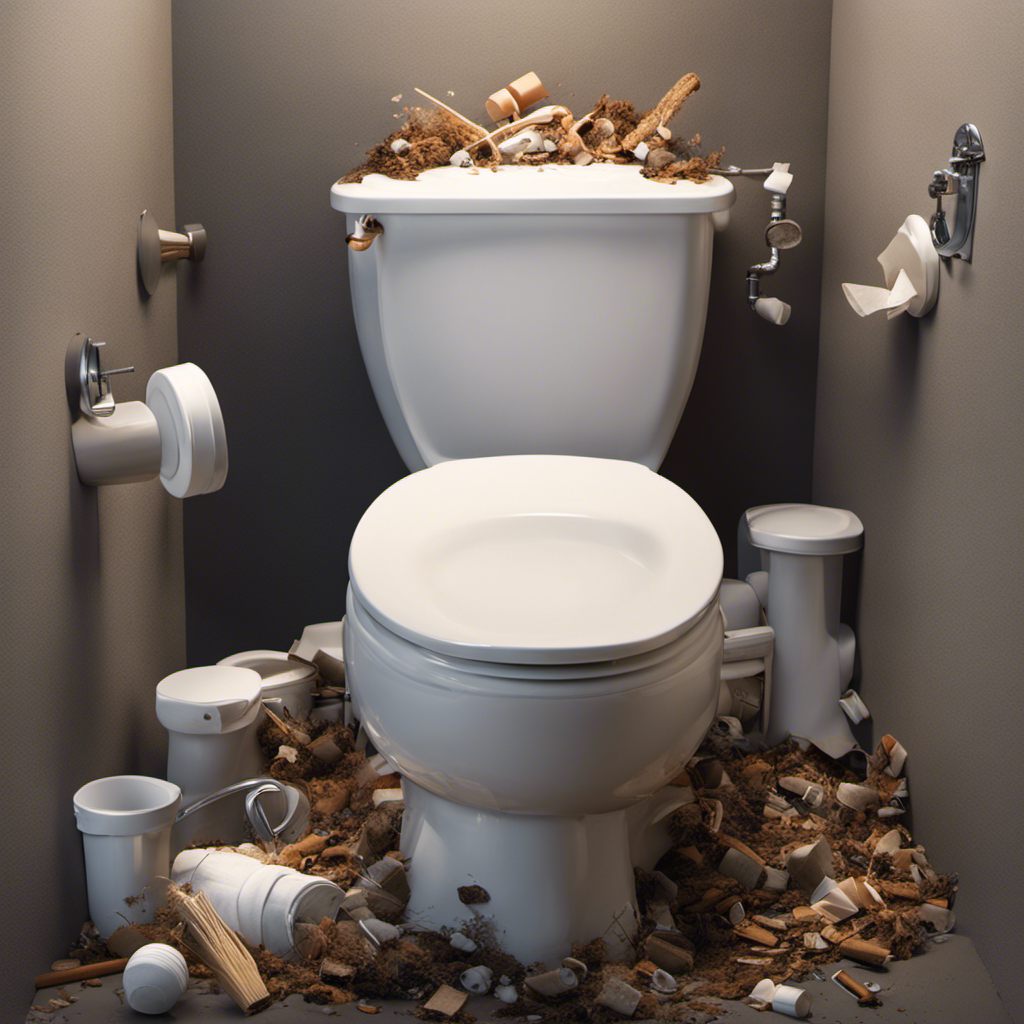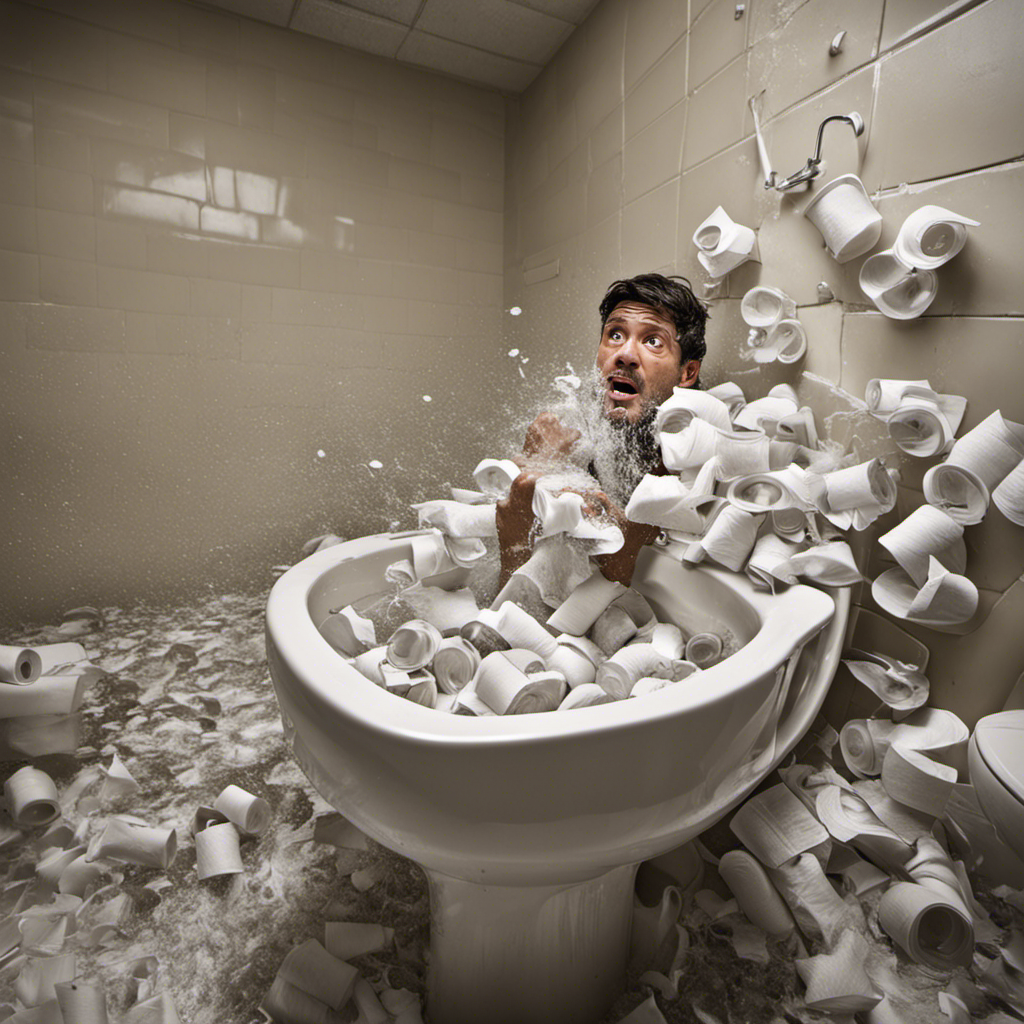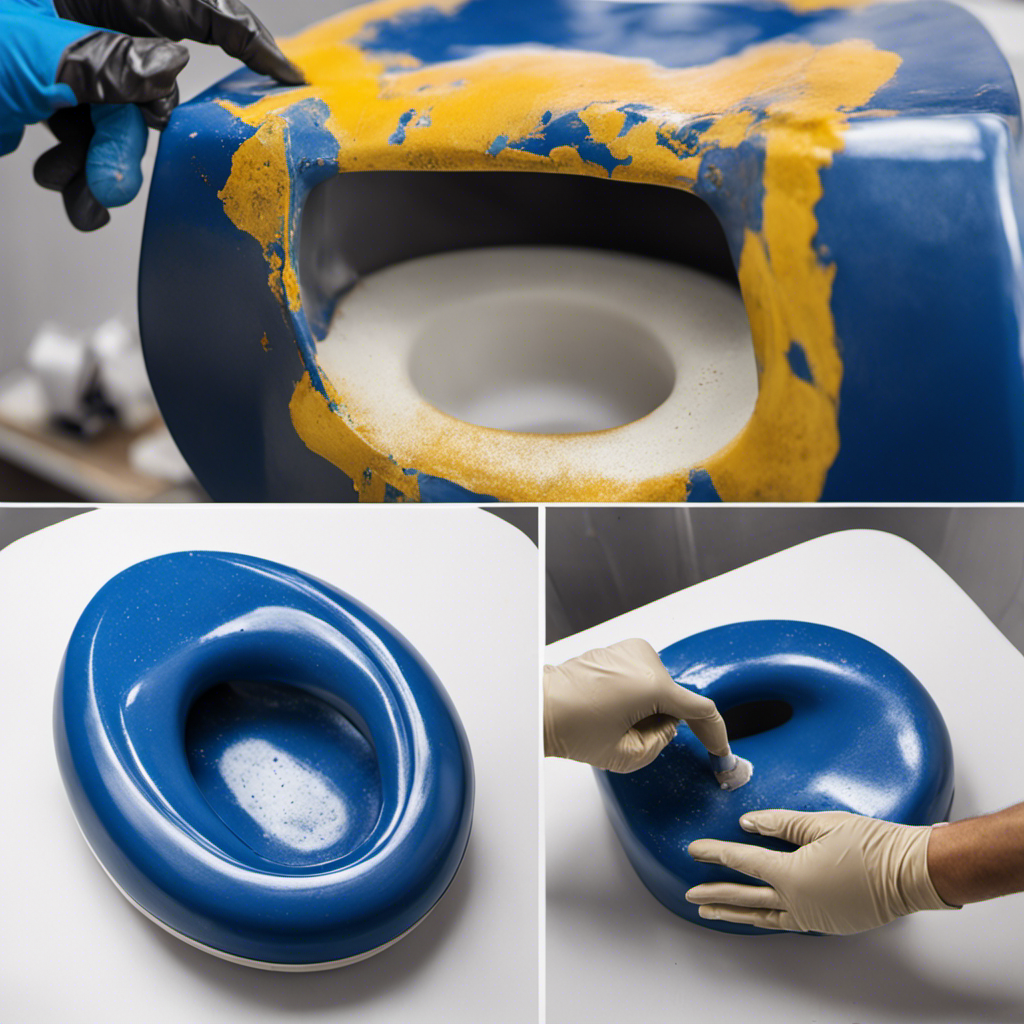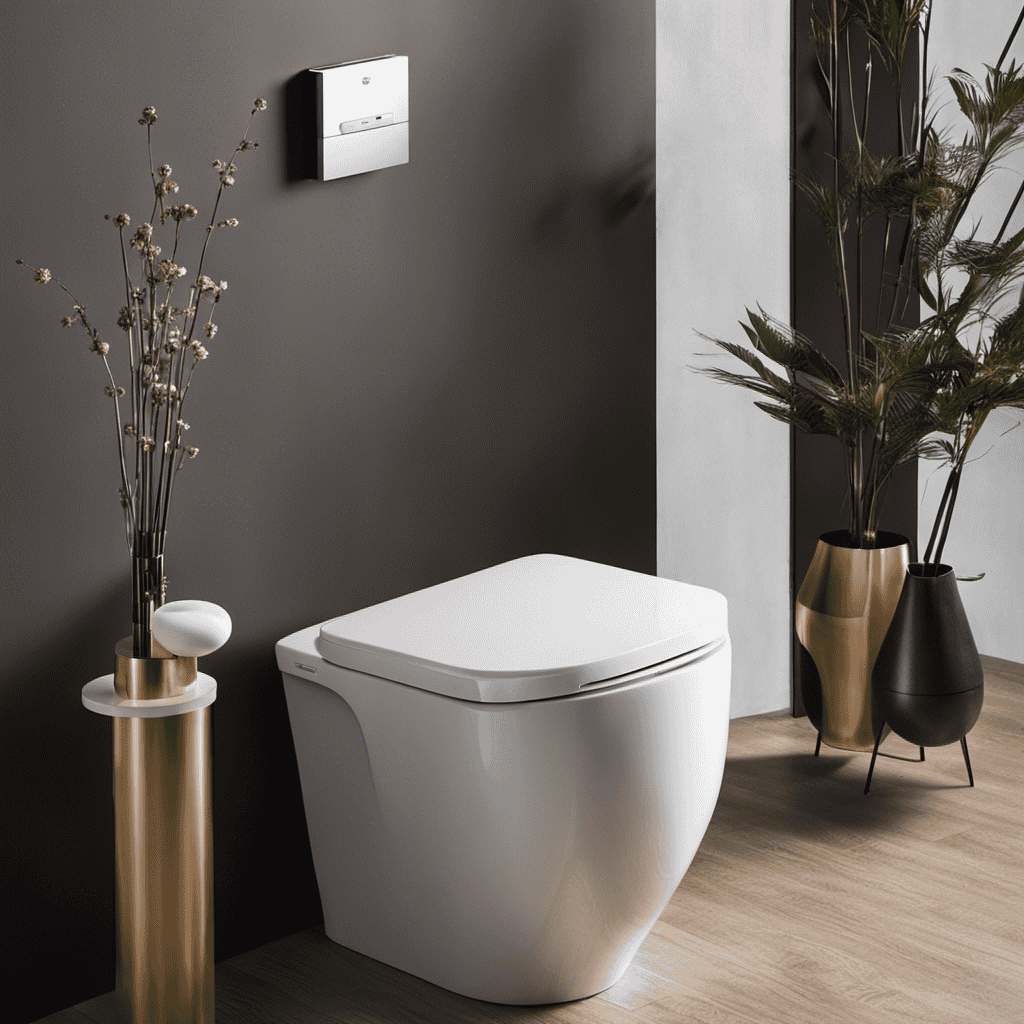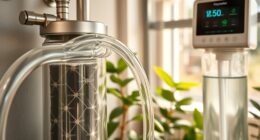Slow-draining toilets can be a frustrating and unsanitary problem for homeowners. But fear not, for there are common causes and simple solutions that can alleviate this issue.
From non-flushable objects causing blockages to clogs in the rim jets and toilet ports, these slow drainage woes can be swiftly resolved.
By increasing the water level in the toilet tank, cleaning the rim jets and toilet ports, and unclogging with tools like plungers or toilet augers, homeowners can bid farewell to sluggish toilets.
Say goodbye to slow drainage and hello to a smoothly functioning bathroom experience.
Key Takeaways
- Toilets can become clogged with non-flushable objects, leading to slow-draining and rising water levels.
- Unclogging tools like plungers, toilet augers, dish soap, or vinegar and baking soda can be used to fix slow-draining toilets.
- Cleaning the rim jets and toilet ports using a toilet cleaner, metal coat hanger, and toilet brush can improve toilet performance.
- Increasing the water level in the toilet tank and removing foreign objects or adjusting the float can help resolve slow-draining issues.
Causes of Toilet Clogs and Slow Drainage
Toilets are prone to clogging, which can cause slow drainage and lead to water rising in the bowl.
Understanding the causes of toilet clogs and slow drainage is crucial in implementing effective preventative measures.
One common cause is improper toilet flushing techniques. Many people are unaware that flushing large amounts of toilet paper or flushing non-flushable items can easily lead to clogs.
It is important to educate individuals on proper toilet flushing techniques, emphasizing the importance of flushing only toilet paper and waste.
In addition, preventative measures such as installing a toilet paper dispenser that regulates the amount of paper used or providing clear instructions in public restrooms can help reduce the occurrence of clogs and ensure smooth drainage.
Non-Flushable Objects Causing Blockages
Foreign objects that are not meant to be flushed down can lead to blockages in the toilet. Preventing toilet clogs is crucial to maintain the proper functioning of the plumbing system.
It is essential to educate individuals on the importance of not flushing non-flushable objects, such as sanitary napkins, baby wipes, dental floss, and paper towels. These items can accumulate in the pipes and cause clogs that result in slow-draining toilets.
To avoid such blockages, it is recommended to have a waste bin near the toilet for disposing of non-flushable items properly. Regularly reinforcing this practice can help prevent costly plumbing repairs and ensure the smooth operation of the toilet.
In case a non-flushable object accidentally gets flushed, it is essential to promptly remove it using appropriate tools or seek professional assistance to prevent further damage.
Long-Term Disposal of Non-Flushable Items Leading to Clogs
Improper long-term disposal of non-flushable items can lead to clogs in the plumbing system, causing water to back up in the toilet and slow drainage. This can have long-term effects on the plumbing, resulting in costly repairs and inconvenience for homeowners.
To avoid these issues, it is important to consider alternatives to flushing non-flushable items. Here are three options to consider:
-
Dispose of non-flushable items in the trash: Instead of flushing items like wipes, sanitary products, and paper towels, place them in a waste bin. This will prevent them from causing clogs in the plumbing system.
-
Use flushable alternatives: Look for products that are specifically designed to be flushed and are labeled as flushable. These can provide a convenient and safe alternative to non-flushable items.
-
Educate household members: Teach everyone in your household about the importance of only flushing toilet paper and waste. This will help prevent accidental flushing of non-flushable items and keep your plumbing system running smoothly.
Clogs in Rim Jets and Toilet Ports
Regular maintenance and cleaning are crucial to prevent clogs in the rim jets and toilet ports, ensuring optimal flushing performance. Neglecting these areas can lead to inefficient flushing, water backup, and unpleasant odors. To keep the rim jets and toilet ports clean, it is recommended to use a toilet cleaner specifically designed for this purpose. A metal coat hanger can also be used to gently remove any debris that may be blocking the jets or ports. Additionally, regular inspection of these areas can help identify any potential clogs before they become major problems. By taking these proactive measures, homeowners can prevent toilet clogs, maintain proper toilet function, and ensure a clean and hygienic bathroom environment.
| Problem | Solution | Benefits |
|---|---|---|
| Clogs in rim jets | Use toilet cleaner and metal coat hanger to remove debris | Prevents water backup and foul odors |
| Clogs in toilet ports | Regular inspection and cleaning | Ensures optimal flushing performance |
| Inefficient flushing | Regular maintenance and cleaning | Reduces the risk of toilet clogs |
| Unpleasant odors | Proper cleaning and maintenance | Promotes a clean and hygienic bathroom environment |
Low Water Level in the Toilet Tank
The low water level in the toilet tank can lead to a weak flush and may indicate a problem with the fill valve or water supply. Maintaining the toilet tank is essential for its proper functioning. Troubleshooting low water levels is crucial to ensure efficient flushing. Here are three important points to consider for toilet tank maintenance and troubleshooting low water level:
-
Check the fill valve: The fill valve controls the water level in the tank. If it is not functioning properly, it may result in low water levels. Inspect the fill valve for any blockages or malfunctions.
-
Examine the water supply: Ensure that the water supply to the toilet is adequate. A restricted or faulty water supply can lead to low water levels in the tank.
-
Clean the tank components: Sediment buildup in the tank can obstruct the flow of water, causing low water levels. Regularly clean the tank components, such as the flapper and flush valve, to prevent any blockages.
Unclogging Solutions for Slow-Flushing Toilets
Using tools like a plunger, toilet auger, or vinegar and baking soda, one can effectively unclog a slow-flushing toilet. These methods are tried and tested solutions that can help remove blockages and restore proper flushing function.
A plunger is a basic tool that creates suction to dislodge clogs in the toilet drain.
A toilet auger, also known as a snake, is a long, flexible tool that can reach deeper clogs and break them up.
Alternatively, a mixture of vinegar and baking soda can be poured into the toilet bowl to create a chemical reaction that helps dissolve and dislodge the clog.
These unclogging solutions are cost-effective and can be easily implemented by homeowners.
Cleaning Rim Jets and Toilet Ports
After addressing the unclogging solutions for slow-flushing toilets, it is crucial to move on to the next step of toilet maintenance: cleaning the rim jets and toilet ports. These components play a significant role in the efficient flow of water during flushing. Over time, mineral deposits, debris, and bacteria can accumulate in the rim jets and toilet ports, leading to reduced water flow and potential clogs.
By regularly cleaning these areas, you can prevent clogs and ensure optimal toilet performance. Here are three important reasons why cleaning rim jets and toilet ports is essential for preventing clogs:
-
Removes mineral deposits: Cleaning the rim jets and toilet ports helps remove mineral deposits that can accumulate over time, restricting water flow and promoting clogs.
-
Eliminates debris: Regular cleaning eliminates debris such as hair, toilet paper, and other particles that can obstruct the water flow and contribute to clogs.
-
Reduces bacterial growth: Proper cleaning of the rim jets and toilet ports helps reduce bacterial growth, ensuring a hygienic environment and preventing potential blockages.
Increasing Water Level in the Toilet Tank
To increase the water level in the toilet tank, one can remove foreign objects or simply lift the float.
Maintaining the correct water level in the toilet tank is crucial for proper flushing and preventing issues such as slow draining. By increasing the water level, you can ensure increased water pressure for a more efficient flush.
This can be done by removing any objects that may be obstructing the float or lifting the float manually to allow more water to enter the tank.
Regular toilet tank maintenance is essential to prevent problems with flushing and drainage. By following these simple steps, you can avoid the hassle of slow-draining toilets and maintain optimal performance.
Other Common Toilet Issues
Leaking toilets can result in water damage to the bathroom floor and require immediate action to prevent flooding. It is essential to address any leakages promptly to avoid further complications.
Here are some toilet maintenance and repair tips to keep in mind:
- Regular inspection and maintenance can help prevent leakages.
- Toilet leakages can occur at the base or from various components such as tank bolts, nuts, or bowls.
- Puddles may be visible around the toilet, indicating a leak.
Toilet repair tips:
- If you notice a leakage, it is important to identify the source and fix the problem promptly.
- Damaged wax rings or faulty seals are common causes of toilet leaks.
- Regularly inspect the toilet components and replace any damaged parts to prevent leakages.
Phantom Flushing and Toilet Leakages
Phantom flushing and toilet leakages are two common issues that can disrupt the proper functioning of toilets.
Phantom flushing occurs when the toilet randomly flushes for a few seconds without anyone using it. This problem is often caused by a broken toilet flapper next to the overflow tube. Fixing this issue is crucial, as it can waste a significant amount of water, impacting water conservation efforts.
Regular toilet maintenance is essential to prevent leakages. Toilet leakages can occur at the base or from various components, such as tank bolts, nuts, or bowls. These leakages can lead to water damage on the bathroom floor and waste a substantial amount of water.
Frequently Asked Questions
How Can I Prevent Toilet Clogs Caused by Non-Flushable Objects?
To prevent toilet clogs caused by non-flushable objects, one should avoid disposing of items like wipes, feminine hygiene products, or paper towels down the toilet. Instead, these items should be properly disposed of in the trash.
What Are Some Signs That My Toilet May Have a Faulty Flapper or Fill Valve?
A faulty flapper or fill valve in a toilet can cause several signs, such as a weak flush, constant running, or improper refilling. Troubleshooting the fill valve or replacing the flapper can resolve these issues effectively.
How Can I Fix a Toilet That Is Not Refilling Properly?
To fix a toilet not refilling properly, check the water level in the toilet tank and ensure the fill valve is functioning correctly. Adjust or replace the fill valve if necessary to maintain proper water pressure.
What Are the Common Causes of Toilet Leakages at the Base?
Toilet leakages at the base are commonly caused by a faulty toilet seal. In order to address this issue, a plumbing inspection is recommended to determine the extent of the damage and to perform necessary repairs.
How Can I Prevent Phantom Flushing in My Toilet?
To prevent phantom flushing in toilets, one can replace a broken toilet flapper next to the overflow tube. This simple fix can reduce water usage and prevent wastage, helping to avoid high water bills.
Conclusion
In conclusion, slow-draining toilets can be a frustrating and messy problem to deal with. However, armed with the knowledge of common causes and solutions, you can tackle this issue with confidence.
Remember, toilets are like delicate ecosystems that can easily be disrupted by non-flushable objects and clogs in the rim jets and toilet ports.
By using tools like plungers and toilet augers, cleaning the rim jets and toilet ports, and adjusting the water level in the toilet tank, you can restore proper functionality to your toilet.
Don’t let phantom flushing or leakages go unnoticed, as they can lead to water damage and high bills.
With a little know-how, you can keep your toilet flowing smoothly and avoid any unwanted surprises.
